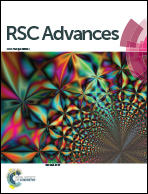Manganese dioxide-core–shell hyperbranched chitosan (MnO2–HBCs) nano-structured screen printed electrode for enzymatic glucose biosensors
Abstract
In this study, the synthesis, characterization and testing of new polymeric–metal oxide nanocomposites for enzymatic glucose biosensors were performed. Among various nano-composites, manganese dioxide-core–shell hyperbranched chitosan (MnO2–HBCs) provided rapid and high efficiency direct electron transfer from the redox active centre of an immobilized enzyme and screen printed electrode. The assay optimization was achieved after testing the effects of several factors such as type of crosslinking agent, accumulation potential, toxicity of heavy metals and interferences on the bioactivity of GOx. Results demonstrated sensitivity of the proposed method to detect inhibition effects of metal ions and also the response of agents interfering with glucose measurement. A chronoamperometric calibration curve was obtained, and the oxidation current of the enzymatically produced H2O2 was linearly dependent on glucose concentration with a detection limit of 7 μg mL−1. Thus, the clinical determination of glucose concentration was performed on blood samples and the results were correlated with a reference method. In conclusion, the current study suggests a new class of electrochemical biosensors and paves the way for further promising applications.


 Please wait while we load your content...
Please wait while we load your content...